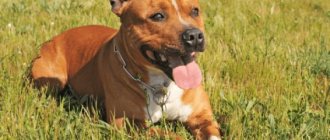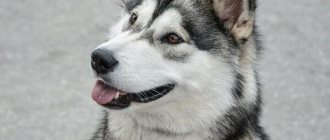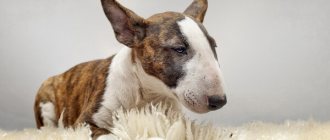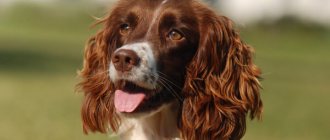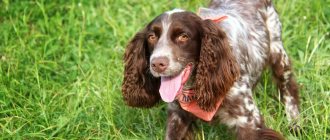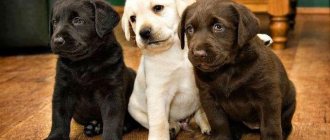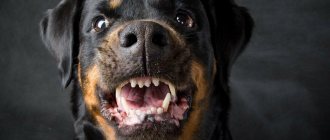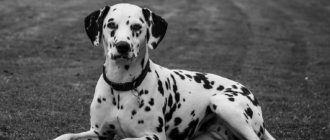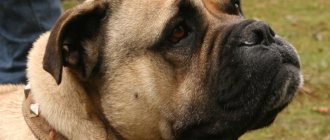- Pets
- >>
- Dog breeds
* Here is a photo of a typical representative of the Staffordshire Bull Terrier dog breed . You can send us photos of your animals by email, and we will post them on the website. Don't forget to send your pet's name.
Other breed names:
English Staffordshire Bull Terrier
Video
* We invite you to watch a video about the Staffordshire Bull Terrier . In fact, in front of you is a playlist in which you can select and watch any of 20 videos about a given dog breed by simply clicking on the button in the upper right corner of the window. In addition, the material contains quite a lot of photos. By looking at them you can find out what a Staffordshire Bull Terrier looks like.
In this article:
|
Breed traits
Breed traits (on a 5-point scale)
| Staffordshire Bull Terrier | |||
| Activity | in the house | 2.7 | |
| on the street | 4.4 | ||
| Obedience | training | 3.1 | |
| strangers | 3 | ||
| Domination | in family | 1.7 | |
| over dogs | 3.4 | ||
| Defending your territory | from people | 1.9 | |
| from dogs | 3.4 | ||
| Sociability | in family | 4.7 | |
| with strangers | 3.3 | ||
| with dogs | 2.7 | ||
| Concentration | in family | 1 | |
| in front of strangers | 1.7 | ||
| with dogs | 2 | ||
| Aggressiveness | in family | 1 | |
| to strangers | 1.7 | ||
| to the dogs | 3.1 | ||
| to cats | 3.6 | ||
| Family behavior | calmness | 3.9 | |
| demand for affection | 4.6 | ||
| excitability | 3.1 | ||
| playfulness | 4.4 | ||
| excessive barking | 1.4 | ||
| behavioral breakdowns | 3 | ||
| Tolerance for children | up to 4 years | 3.7 | |
| over 4 years old | 3.9 | ||
| Institutional use | watchman | 3.9 | |
| bodyguard | 2.6 | ||
This breed is often compared to the following dog breeds: American Staffordshire Terrier, French Bulldog, Bull Terrier, Beagle, German Shepherd.
The photographs show what a Staffordshire Bull Terrier looks like:
History of the origin of Staffordshire bull terriers
The Staffordshire Bull Terrier is often called a Staffy Bull or Staffy. Dogs owe their origin not to any trends of the times or certain needs, but to the search for profit. In the first half of the 19th century, poor Englishmen found such entertainment as dog fighting, which began to gain not only popularity, but also generate income. The dogs fought for a reason, but for money in the form of bets. The presence of money stakes further interested the crowd in this brutal competition.
Initially, bulldogs took part in the fights, then they began to use various terriers. Gradually, fighting became commonplace and was no longer of much interest to the poor, so dog owners began to think about creating a dog color that would stir up unprecedented interest in fighting and enrich them.
Experiments began, during which bull and terriers appeared. They were the result of crossing bulldogs with English terriers. Such dogs fought more skillfully, were much more resourceful, more passionate and had lightning-fast high-speed reactions. In addition, the four-legged animals had an excellent mouse-catching ability, which is why a new show in the form of rat baiting became popular.
Further improvement and experimentation with the bull and terrier breed proceeded spontaneously; the breeders had no restrictions in this regard.
The result was the emergence of three types of staffies:
- The Warlaston type was distinguished by its small size, optimal fatness and short limbs, like a bulldog;
- The cradle type was compact, but strong, had a developed and powerful backbone;
- The Varsol type is more similar to terriers, distinguished by long legs and a lean figure.
Staffies acquired their current appearance, characteristic of modern dogs, closer to the second half of the 19th century. The breed standard was established only in 1935, when dog fighting became illegal. The standard for the appearance of these dogs was the Cradley type, in which stockiness and power were visible.
Staffordshire Bull Terrier - description of the breed
Staffordshire Bull Terriers can be called smooth-haired, stocky, big guys with a powerful chest and a highly intelligent gaze that monitors everything around. Outwardly, Staffies are similar to pit bulls, but they also have their own characteristics that are unique to this breed.
Interesting fact: Among the obvious differences, it is worth noting that the Staffie is smiling, which he owes to his developed cheek muscles and wide skull, and the dog is shorter in stature than a pit bull. The height of a Staffie at the withers can reach 40 cm, the weight of males varies from 17 to 20 kg, and females - about 15 kg.
The shape of the Staffie's skull is quite wide, but at the same time it is compact, the stop is clearly visible, and the muzzle itself is short compared to the entire head. The presence of powerful and developed jaws is immediately noticeable, because dogs have an outstanding grip. The bite should be full and correct. The tip of the dog's nose (lobe) is of medium size and rich black in color. Dog eyes that are round, straight and dark in color are considered ideal for a Staff Bull. But in life there are often dogs with a light iris color, which is in complete harmony with the coat color.
The staffbull's ears are shaped like a flower petal, are semi-erect and not very large. A unique feature of the dog is its neck, which looks quite dense and short, making the physique stocky, strong and squat. The whole figure of the Staffie is quite well-built, powerful, the dog's body is slightly elongated, has a perfectly straight back, a deep and solid chest, spreading out in width.
The front limbs of a dog are slender, have shoulder blades laid back, fairly powerful, strong wrists and paws that look outward. The hind legs are more muscular, with sloping shins and low hocks. The dog's tail is not particularly long; it is short, straight and set low.
Popular colors of Staffordshire bull terriers
Staffbulls are classified as short-haired dogs; they have a fairly tough coat in tandem with rough animal skin, perfectly adapted to protect the body during fights and fights. These dogs do not have undercoat.
Popular (most typical) colors include:
- Amber;
- Reddish;
- Light dominant;
- Gray (blue);
- Black.
It is worth noting that a two-tone color combination is acceptable; previous markings in the color are not considered a fault. Let's try to describe in more detail some dog colors.
The red colors of Staffbulls are quite popular and are diverse, differing in some shades and range. For example, the sable color is considered to be a dog's fur coat, the main tone of the hairs of which is red, and the tips are dark.
Often dogs of this color have a kind of dark mask on their face. Many experts consider the gray (blue) color to be bleached black. Such four-legged animals often have lighter eyes and nose. The zone gray color includes dogs that have a solid gray coat, a black nose and dark eyes.
Interesting fact: Staffies also have brindle colors. It may have rare dark stripes against a general background of red or light color, but it happens the other way around - the black background is diluted with infrequent lighter streaks (stripes), this color is called dark motley.
As already noted, white spots are inherent in various colors of Staffbulls; they are not considered defects. Many dogs have rare (single) small white spots against a general monochromatic background. In other four-legged animals, on the contrary, very little dark color remains; it turns into separate spots, so the dogs look almost white. Undesirable colors of the Staffordshire Bull Terrier include tan (black and tan, brown and tan) or liver-colored coat.
Appearance
Staffordshire Bull Terriers are a medium-sized dog breed. Characteristic features of appearance: short hair, stocky build, powerful chest, wide smiling muzzle and an attentive, intelligent look. The average weight of a Staffordshire Bull Terrier is 15-17 kg, but in males it can reach 20 kg. Height at the withers is 35-40 cm.
Head
The skull is wide, the stop is well defined. The muzzle is rather short in relation to the head. The nose is black and medium in size. The cheeks are well developed and close fitting. The jaws are strong and provide a death grip. The teeth are large, scissor bite.
The eyes are round and dark. A lighter iris is possible in individuals with blue, sand or cream colors. The ears of the Staffordshire Bull Terrier are small and triangular. They are semi-erect, in the form of a rose petal. A puppy's ears do not take the correct shape right away; sometimes it is necessary to glue the tips.
Frame
The short, muscular neck makes this dog appear stockier. The physique is strong, with strong bones and pronounced muscles. The body is slightly stretched in length. The back is straight, the chest is wide and deep, reaching to the elbows. The tail is set low and carried straight. Wide at the base, tapering towards the tip, rather short.
Limbs
The front legs are straight, parallel, and set wide apart. The shoulder blades are pulled back, the elbows are pressed tightly to the body. The hind legs are muscular, the hocks are low. Paws are medium-sized, compact, with strong claws. Movements are light, free, limbs move in parallel, there should be no clubfoot.
Coat and colors
The coat is short, very dense, shiny. It is tough, which, combined with rough skin, protects the dog from bites. There is no undercoat, so in winter Staffbulls require clothing when walking.
According to the standard, the Staffordshire Bull Terrier can have the following colors:
- pure black or black and white;
- red, sable, brindle;
- blue, zonal gray, blue with white;
- white with spots of any color.
Dogs of any color can have small or large white spots on their body; this is allowed by the standard. Sometimes there is a black mask on the face. Tigers can be black with red stripes or vice versa. Black and tan, brown and tan and liver colors are not acceptable.
Photos of representatives of the breed complement the description of Staffordshire Bull Terriers:
Differences from similar breeds
Related breeds are the American Staffordshire Terrier, Pit Bull and Bull Terrier. They all have common ancestors - English bulldogs. These are fighting breeds, bred for fighting. It seems that they are similar, but in fact the differences between the English Staffbull and the others are clearly noticeable.
- It differs from the American Staffordshire Terrier in its wider muzzle with a characteristic smile. Another difference is that the Staffbull does not have docked ears and tail, and is smaller in size. This is a companion dog, and the Stafford is a service dog.
- The American Pit Bull Terrier or pit bull is a larger dog, up to 50 cm tall and weighing up to 27 kg. The breed is not officially recognized, it is a service breed. It is because of these dogs that staff bulls have such a negative reputation, as they are quite aggressive. Another difference is that pit bulls’ ears are cropped, and their cheeks are fleshy and hang down.
- The difference with the standard bull terrier is clearly visible. This breed was also bred in England, in the 19th century. English bulldogs and terriers were used for breeding, but also Dalmatians. Unlike the Staff Bull, the Bull Terrier is taller at the withers - up to 56 cm, its muzzle is elongated, egg-shaped, its eyes are narrow and deep-set.
Character and habits of Staffordshire bull terriers
Many people mistakenly believe that Staffbulls are too aggressive and unfriendly, apparently due to their fighting history of origin. This is not entirely true. Today's dogs can be confidently called peaceful and quite friendly animals. Experts assure that Staffies are the most people-oriented dogs, although their appearance does not confirm this.
A well-mannered and balanced bull terrier has great respect for his owner and values friendship with him above all else; for him, communication with his beloved friend is the most precious reward. The four-legged dog is ready to act as an escort everywhere, so you need to understand that the staff’s attention will be constant.
Staffies do not experience great joy when they see other dogs or cats, but they are not particularly bloodthirsty towards them. Of course, running after an onlooker or teaching a dog a lesson is considered natural for them. It is possible to train a Staff Bull to live under the same roof with other pets, but this must be done diligently from the dog’s childhood.
Interesting fact: Staffordshire Bull Terriers are very friendly towards children, because... They are not considered rivals. They behave with children affectionately and prudently, trying to show care and attention. It is very interesting to watch the changing emotions of a staffie when he sees a child.
Even if a few minutes ago the dog was having a showdown with some other dog, when it sees a child, it immediately transforms and can begin to lie right on the territory of the playground, waiting for the little one to show attention and scratch the four-legged belly. Of course, you need to monitor such communication, because provocations from children can be sophisticated. But time shows that staff bulls do not enter into conflict with the inhabitants of sandboxes, showing restraint and friendliness.
A dog with a fighting history imposes certain obligations on its owner, primarily regarding training and socialization, which cannot be evaded, because an ignorant staff bull who does not know the commands is a threat to others. Yes, aggressiveness towards people and other animals in these dogs is reduced, but no one is talking about complete harmlessness. The best and optimal training program for Staffies is the General Training Course (GCC).
When training, you will have to show patience and endurance, the main thing is to assert your authority. Staffbulls are distinguished by stubbornness, a certain self-will, which results in them changing commands and acting at their own discretion. It is worth noting that putting pressure on dogs will not help matters, but will only make everything worse; staffies will not tolerate cruelty and rudeness.
Education and training
Keeping a dog with a fighting past imposes a number of obligations on its owner. In particular, teaching a pet the basics of behavior and its socialization are tasks that cannot be avoided no matter how hard you try, since an ill-mannered Staff Bull who does not understand commands is always a threat. Yes, the level of aggression towards humans and our smaller brothers is reduced in this breed, but this does not mean that its representatives are completely harmless.
Tug of War
The optimal training program for the Staffordshire Bull Terrier is considered to be OKD (General Course of Training), although simplified options like UGS (Controllable City Dog) are also not excluded. Passing the ZKS (Protective Guard Service) for staff is not necessary, but in practice it does occur. At the same time, it is important to understand that a representative of this breed will not make some kind of fantastic bodyguard. Firstly, the height of the Staffordshire Bull Terrier does not make much of an impression on bullies. Secondly, after the animal undergoes training, all you can count on is barking at an approaching stranger and trying to attack an enemy who happens to be near the pet at a distance of 2-3 m. It seems not so bad, but, you must admit, that a barking Staff Bull and a teeth-clattering Caucasian Shepherd are two completely different degrees of threat.
When training and raising a Staffordshire Bull Terrier, you will have to be patient and work on establishing your own authority. Representatives of this breed are stubborn creatures who love to change the requirements placed on them and act according to their own preferences. With all this, putting pressure on a staffie will not work: these dogs cannot stand harshness and, in response to rough treatment, generally stop listening to the owner’s orders.
Grace itself
It is very important to develop the skill of obeying commands in your pet in a timely manner. You can only be confident in a Staffordshire Bull Terrier if it follows orders immediately and without hesitation, which is why experts do not recommend repeating a command twice. Staffbulls are cunning creatures who have perfectly mastered the art of manipulation. Let them "not hear" the call once, and subsequently they will force you to beg them every time you need to do something.
When raising a tiny puppy, you can and should follow the standard program. First, the baby learns a nickname to which he must respond. By the way, as in the case of commands, it is better not to overuse repetitions here. At 2.5 months, if the weather permits, you can go outside with the Staffordshire Bull Terrier, developing the habit of calmly reacting to unfamiliar phenomena and sounds. After 2-3 weeks, when the puppy gets used to street noise, he needs to find company for communication. The optimal option is a small get-together of several puppies and phlegmatic adults, in which the young staffie should occupy the appropriate hierarchical niche.
Catch-up
The Staffordshire Bull Terrier is an enthusiastic and emotional dog, so it gets bored with monotonous lessons. To better assimilate the educational material by the pet, it is recommended to break the hour-long lesson into five-minute sessions, during the breaks between which the four-legged student is allowed to fool around and play to his heart's content. Remember also that Staffordshire Bull Terrier puppies have a predominant short-term memory, thanks to which kids grasp new knowledge in a split second and forget it just as quickly. So don't try to fit a bunch of techniques into one lesson. It’s better to fully practice one skill, honing it to perfection in subsequent training. It is better to start training a Staffordshire Bull Terrier puppy with basic dynamic skills, that is, by approaching the owner’s call, bringing a toy, moving next to a person during a walk (without pulling on the leash). When the material is mastered and practiced to the point of automatism, it can and should be supplemented, since the best method of training staff bulls was and remains the principle “from simple to complex.”
Interesting facts about Staffordshire Bull Terriers
There are different opinions about such an amazing and extraordinary dog breed as the Staff Bull, but there are a number of interesting facts that take place. They characterize the image of this four-legged person, describing her from various angles.
Let’s try to cite the most interesting ones, listing them point by point:
- The adjective “Staffordshire” was assigned to the bull terrier due to the fact that the breed appeared in the English county of Staffordshire in the 19th century;
- The Staffordshire Bull Terrier is often called a “nanny dog” because of its affectionate and friendly attitude towards children;
- The talent of a rat catcher is in the staffbulls' blood. The most famous in this regard was the dog Billy, who in 1823, in a five-minute period of time, strangled a hundred rats that were furiously attacking her;
- For decades now, Staffbulls have been the living mascots of the Prince of Wales's Staffordshire Regiment;
- In order to develop this particular breed, bulldogs were crossed with all kinds of terriers;
- Recognition of the breed standard occurred in 1974, since then bull terriers have been divided into American and English;
- Staffies have a high pain threshold, so they can endure even serious damage (injuries) very patiently;
- Staffy bulls cannot be overcooled or overheated, so these dogs are recommended to be kept in apartments;
- Staffies are real athletes, they can show class in such sports disciplines as: freestyle, frisbee, coursing and agility;
- The Staff Bull is a dynamic and active breed that prefers an accelerated rhythm of life with fun and active games and grueling runs to lying on the couch.
Pros and cons of Staffordshire Bull Terriers
Like any other breed, Staffies have their advantages and disadvantages, although owners consider their pets simply ideal. Let's try to look at staff bulls objectively and from the outside, describing all the pros and cons of keeping them.
Staffie advantages:
- Boundless love, respect and devotion to its owner are, of course, the undeniable dignity of a dog, but it is formed through careful training and training;
- Love for children can also be considered a plus, since these powerful four-legged animals are very kind to toddlers and take care of the kids, like real nannies;
- The compact dimensions testify in favor of the breed; such a dog is convenient to keep both in a large house and in a medium-sized apartment;
- Short hair is an important advantage, because it does not require special care, and there will be no tufts lying around;
- The dog is unpretentious in maintenance, which is a tangible advantage;
- Friendliness towards others is very important, especially with such a powerful and uncompromising canine species;
- Among the advantages include having courage and fearlessness.
Disadvantages of the breed:
- The main disadvantages include human opinion, which is often negative towards this dog due to its aggressive past. People react warily to Staffies, considering them dangerous. Although, if you remember, these four-legged creatures fought only with their own kind, without attacking humans;
- The requirement of training is a disadvantage for many owners, but for a Staff Bull, training is very important, because such a dog needs to be taught communication and obedience skills from childhood;
- Excessive energy can also be considered a disadvantage; you need to do a lot with a Staffie, developing not only his intelligence, but also his motor activity, and this should take a lot of time, because The dog needs long and dynamic walks;
- Stubbornness of character is also considered a disadvantage; because of this trait, many difficulties arise during training, so you should be patient.
Breeding Staffordshire Bull Terriers
The mating of Staffbulls is not unusual; it is quite standard. Medium dimensions do not require a huge space or special conditions, but for the first mating it is better to call an experienced specialist in this matter who can help not only the dogs, but also their owners.
Staffies become sexually mature closer to ten months of age, but it is better to breed starting from 20 or 25 months, then the dogs are ready not only to conceive, but also to bear strong offspring. The most favorable period is considered to be the days from 13 to 15 from the time the third estrus began. The female these days can be either in a playful mood or slightly aggressive.
If the dogs are breeding dogs, have a pedigree, then mating must be done through a kennel; this requires filling out a special form and obtaining a certain certificate. Owners must agree in advance on the amount and time, which are usually set by the owner of the dog. Most often, it is a percentage of the price of the entire litter or is equal to the cost of one puppy.
Interesting fact: Dogs are introduced while walking together, this takes no more than 20 minutes. Then the female is taken into the dog’s possession so that he feels confident. Many owners believe that a male dog accustomed to domestic intercourse will not look for a passion on the side.
The female allows mounting if she is satisfied with everything; during intercourse, which lasts about 15 minutes, it is recommended to hold the bitch by the head. Repeated mating is carried out a couple of days after the first one. Most often, there are from 6 to 8 puppies in a litter, and the canine life expectancy of Staffbulls is 14 years.
Staffordshire Bull Terrier and Staffordshire Terrier - differences
Having common roots, these breeds were separated as a result of the migration of Europeans to the American continent. Starting from the middle of the 19th century, their development and evolution proceeded separately from each other. The Staffordshire Bull Terrier and the Staffordshire Terrier are very similar, but there are differences between them. The first one has less mass and height, and this dog is also stockier and has a less elongated body.
The American stands out for his slenderness and leanness, with a more elongated muzzle. The latter of the bull terrier is much wider than that of its brother. In general, the described breed is closer to its ancestor - the bulldog, but the resident of the American continent is more like a typical terrier. In addition, the Bull Terrier has a softer, friendlier character.
Caring for Staffordshire Bull Terriers
Short-haired bull terriers do not require special care for their fur coat; they can be brushed during shedding periods (spring and autumn). There is no constant need for this procedure; it rather acts as a stimulating massage. Water procedures should be carried out monthly, but only once. The Staffie should be washed with a diluted shampoo designed specifically for dogs with short hair. Dry your pet by simply blotting the towel; you can comb your pet using a rubber mitten.
Important fact: It is prohibited to take a staff bull outside when it is not dry, it is dangerous for him. In winter, the four-legged dog can be washed less often, once every 2 or 3 months.
It is imperative to inspect the dog’s ears and eyes, rinsing them with a moistened cotton pad to remove dust and accumulated wax. Watery eyes and an unpleasant smell from the ears indicate a health problem, so it is better to consult a veterinarian. The most common and burdensome procedure that a staffie needs to perform is toothbrushing. It is carried out with a brush and a special paste (powder) about four times per week.
It is also necessary to trim your bull's claws. When it’s warm, the claws are worn down from constant walking, so they need to be trimmed a little or polished with a file. In winter, haircuts are done quite often, before immersing the claws in warm water for steaming so that they soften a little.
Physical activity and constant activity are the most important life attributes of Staffbulls, but everything needs moderation. Puppies up to one year of age are not overloaded with strong training. Only older and mature dogs are offered entertainment such as chasing a cyclist, playing tug, Frisbee, etc.
You should beware of walking in intense heat, when the sun is mercilessly scorching. This breed is also afraid of severe frosts, but it reacts calmly down to minus 15 degrees, although warm overalls and special shoes will not hurt. It has been noted that males require more time for walks than females. Of course, for a successful and healthy life for pets, one should not forget about timely vaccinations and deworming measures.
How to buy a Staffordshire Bull Terrier puppy
It is recommended to buy a puppy from a kennel. You need to find a reputable breeder. This is a guarantee that the dog will be purebred, without hereditary diseases and with a stable psyche. It is important to study documents, certificates of the absence of hereditary diseases. Before purchasing, you need to look at the conditions in which the animals are kept and how the mother behaves.
The price of a puppy depends on the pedigree of the parents. On average it is 25-40 thousand rubles. The offspring of champions will cost 50-70 thousand. Prices also vary depending on the color of the dog. The most expensive ones are red ones. A brindle or gray Staffy Bull can be bought for 15-20 thousand.
When choosing, you need to pay attention to the behavior and appearance of the puppy. He should have:
- playful, active behavior, curiosity;
- it is desirable that he makes contact well and does not show cowardice or aggression;
- eyes and ears are clean, without discharge or unpleasant odor;
- the coat is smooth, shiny, without bald spots;
- The tummy is not bloated, soft.
When choosing the gender of a dog, you need to take into account their characteristics. Bitches are more obedient and affectionate. They are devoted to their family, more sociable and easier to train. Males are larger, more active and stronger. But they tend to dominate, more often they show stubbornness and independence. It is recommended to buy male dogs if you plan to attend exhibitions. After all, they have more pronounced breed traits.
The photo shows what the puppies look like:
The video will help you understand whether it is worth getting a Staff Bull:
Video: Staffordshire Bull Terrier dog - a strong, smart and kind pet
Video: Staffordshire Bull Terrier - a companion dog. Briefly about the breed. Upbringing. Training.
Video: Loyal and kind Staffordshire Bull Terriers
English Staffordshire Bull Terriers are dogs that can become loyal friends and companions only with proper training. Therefore, they are not suitable for everyone. They need a lot of attention, exercise and training. Then you will get a friendly, affectionate and devoted pet.
Diet of Staffordshire Bull Terriers
Despite the fact that staffies are not large in size, they love to eat. They need this to replenish energy after walks and training sessions. For mature dogs, 500 to 700 grams of ready-made food, diluted with water, should be enough per day. Portion parameters are related to the dog’s activity, its weight and age, as well as the time of year, because in winter the need for food increases.
Puppies up to three months of age eat 5 or 6 times a day. Up to 6 months they are fed 3 or 4 times a day, and then they are transferred to twice a day feeding. When teething and changing teeth, dogs need to be given solid food, preferably in fairly large pieces. Naturally, each owner makes a choice between dry food and home-cooked food. The first option is more lightweight. But you should be careful when choosing a brand of food, having learned everything about its composition and balance.
Choosing a natural diet is more burdensome, but no less (and maybe more) beneficial. When the owner is involved in the process of preparing and buying food for the dog, he knows everything about its composition and quality, which is important.
The menu should consist of:
- Meat (beef, chicken, rabbit and lamb);
- Fish (sea, boiled and with selected bones);
- Eggs (a couple of times a week);
- Fermented milk products;
- Cereals (buckwheat, rice, oatmeal);
- Fruits and vegetables.
Fatty, salty and fried foods should be excluded; smoked, sweets and flour foods should also not be eaten. These dogs should not be given bones; they should be kept away from pork, potatoes, citrus fruits, grapes, melons, butter and legumes. Maintaining a drinking regime is considered important, so you need to make sure that there is always water in the bowl, and take bottles of water for walks in the summer.
Maintenance and care
The Staffordshire Bull Terrier is unpretentious and does not take up much space in the house. Due to its short coat, the breed is not suitable for kennel keeping. You can only leave your pet outside when it’s warm. The site must have a high fence and solid soil to prevent it from undermining.
In winter, when going for a walk, you need to put clothes on your Staffbu. And in the heat, try not to strain him with physical activity. Due to the short muzzle, thermoregulation is slow and the dog can overheat.
You need to walk an adult dog 2 times a day for 1-2 hours. In the city you will definitely need a leash and a muzzle for this. It is advisable to take your pet out into nature more often, where he can run around. Staffbulls love to dig and explore new territories.
At home, the dog needs a soft bed and two bowls for water and food. It is advisable to place them on a special stand. It is important that your pet has enough toys, as Staffbulls love to chew on something.
Hygiene
The Bull Terrier's short coat is easy to care for. It only needs to be brushed during the shedding period. Although if a dog lives in an apartment where it is constantly warm, it can shed all year round. But the fur is short and close-lying; to remove dead hairs, you just need to walk over the body with a stiff brush or rubber mitt.
You can bathe your pet once every 1-2 months using shampoo for short-haired breeds. Drying it after a bath is easy - just wipe with a towel. But you can’t go outside after that for another 2-3 hours. Every time after a walk you need to wash and inspect your paws. If necessary, you can wipe contaminated areas on the body with a damp cloth.
Other hygiene procedures are simple. Wipe your eyes daily, but Staffbulls are not prone to eye diseases. Check and clean your ears once a week. Every other day, it is recommended to brush your pet’s teeth, this will protect him from the formation of tartar. Instead of cleaning, chewing bones can sometimes be given. In the summer, the claws usually grind down on their own, but in the winter they need to be trimmed with a nail clipper, then sharpened with a file so that they do not peel off.
Nutrition
The Staffordshire Bull Terrier loves to eat. You can feed him both natural food and dry food. Just don’t mix the two types of food. A puppy is fed 5-6 times a day, an adult dog - 2 times.
With a natural diet, the main part of the diet is lean meat, in quantity - 25 g per 1 kg of weight. The pet is given chicken, veal, beef, rabbit. The meat is mixed with cereals and vegetables. Several times a week you can give offal, sea fish, eggs, fruits, and dairy products. Food from the human table, fried, fatty foods, tubular bones, and legumes are prohibited. You should not give sweets, baked goods, or potatoes.
When choosing dry food, you should give preference to premium or super-premium options. They should be designed for active medium breed dogs. The pet will need 500-700 g of food per day.
Health
Dogs of this breed have good health and a stable psyche. With proper care and the creation of suitable conditions, they live 13-14 years. The following genetic diseases are found in representatives of the breed:
- hip dysplasia;
- urolithiasis disease;
- cataract;
- entropion;
- pathologies of the respiratory system;
- epilepsy.
Sometimes these dogs suffer from flatulence, volvulus, and allergies. When walking your pet in nature, you need to carefully monitor it. If a Staff Bull gets injured, he may not notice it due to his insensitivity to pain.
To protect your dog from infections, you need to vaccinate in a timely manner. Already upon purchase, the puppy must have a veterinary passport, where all vaccinations are noted. Every 3-4 months it is necessary to give anthelmintic drugs. And in the warm season, treat the wool from external parasites.
Diseases and health problems
Staffordshire Bull Terriers are mentally stable and physically strong enough. The genetics of this breed are strong, hardy, they are not sensitive to pain, but this can also play a bad joke when the disease is detected in the very last stages. Young puppies can pick up all sorts of infections, especially before they reach one year of age, so vaccinations play a very important role here. They do not provide a complete guarantee that the pet will not catch the infection, but it will be easier for a vaccinated dog to overcome it.
Staff bulls have the following types of diseases:
- Dysplasia of the hip and elbow joints, this disease is hereditary, resulting from excessive physical activity, is expressed by the presence of acute pain, limping, deformed paws, and is considered incurable;
- Brachycephaly, which is expressed by problems with the respiratory system, can occur with varying degrees of severity;
- Epilepsy;
- Deafness;
- Cataracts;
- Frequent bloating;
- Urolithiasis;
- Tendency to volvulus;
- Food allergic reactions.
Many high-quality kennels screen dogs for the presence of dysplasia and patella, which leads to the exclusion of affected animals from participation in the breeding process. Tests that detect cataracts and epilepsy are considered desirable, because No effective treatments for these diseases have yet been found. It should be added that it is important to take care of the pet, constantly examine it, and monitor its behavior and mood. If the owner notices any deviations in time, then serious negative consequences, in most cases, can be avoided.
How to choose a puppy
Mom with puppies
- A normally developing Staffordshire Bull Terrier puppy should be playful, curious and very active (the animals become calmer with age). If the baby is too phlegmatic and thoughtful, there is clearly something wrong with him.
- If a small staff bull does not make contact, becomes hysterical and tries to hide, this signals an unstable psyche. Usually, before purchasing puppies, they undergo the Campbell test, which helps determine the individual character traits of each baby.
- Males and females of the Staffordshire Bull Terrier differ both in appearance and in character. If the aesthetic characteristics of a puppy play an important role for you, it is better to choose doggies. They are larger, stronger and generally have more pronounced breed characteristics. Staffy bull females are suitable for those owners who need a more manageable pet. “Girls” are more strongly attached to the family, they are more temperamental, are not prone to leadership and are easier to train.
- Carefully inspect the nursery and the puppies' habitats. Babies and their parents should not live in cramped, dirty cages.
- Ask the breeder or nursery staff for the results of testing the litter for genetic diseases. If there are no certificates, the seller is most likely inexperienced and is engaged in breeding solely for personal enrichment.
